Nashville International Airport (BNA)
Nashville International Airport (BNA) serves air carriers as well as general aviation, cargo operations, and the military. It boasts three parallel runways, as well as an intersecting runway. A complex series of taxiways provides access to terminals, FBOs, and cargo ramps, located on all sides of the airport. View a printable Pilot Handbook of the BNA information found on this Web page.
Know Before You Go
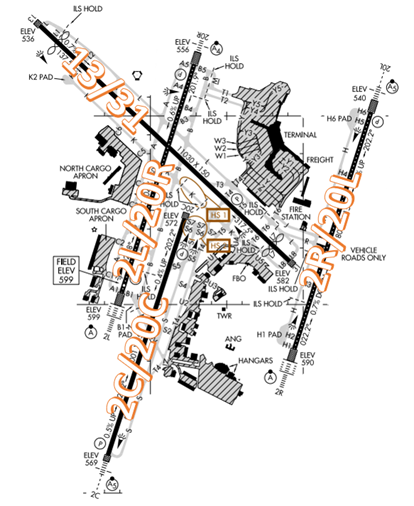
BNA ATCT operates 24 hours
Administrative Office Open 0800L to 1700L M-F
Business Phone 615-695-4594
The RWY configuration consists of three parallel RWYs 2L/20R, 2C/20C, and 2R/20L along with intersecting RWY 13/31.
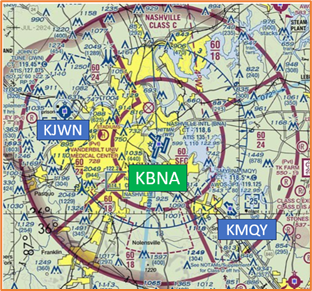
The airspace at BNA is Class C and was recently expanded. It is now surface to 6000’ within 7 miles of BNA. From 7-15 miles, it varies between 1800’ to 6000’ and 2400’ to 6000’, with cutouts for JWN and MQY. (Refer to Sectional Chart)..
Below find various BNA-specific information and things to be aware of, as well as general information to inform your preflight planning. This will be reviewed quarterly and updated as needed. This information is to supplement the From the Flight Deck Videos that are produced by the FAA Runway Safety Group. Here you will also find information provided by the local air traffic controllers at the airport where you intend to fly. The information is subject to change. Not for navigation or legal* pre-flight action. Always refer to official pre-flight materials such as, but not limited to, NOTAMs, airport diagrams, VFR charts and airport construction notices for the latest airport-specific details.
Hot Spots
HS1 Maintain vigilance as hold bars on TWY K between TWY B and TWY T4 protect RWY 20C approach.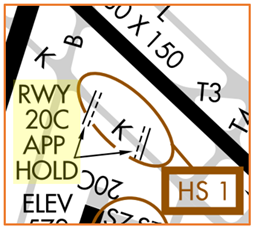
- TWY K is in the approach area for RWY 20C. Pilots have failed to hold short when instructed even after reading back the correct hold short instructions. This may result in aircraft on final for RWY 20C executing a go-around.
- Pilots should review the taxi clearance before starting to taxi. Actively scanning to locate and identify RWY signs, markings, and lighting and deferring all heads down activities until holding short at the appropriate location will help eliminate these errors.
- It is always okay to verify with the TWR when you are unsure whether to hold or proceed.
HS2 Maintain vigilance as TWY S is often mistaken for RWY 20C departure surface.
- Although TWY S is marked, lighted, and only 75 feet wide, its shoulders are wider than typical on the north end because it used to be a RWY in the past. Pilots taxiing to RWY 20C via TWYs S6 or S7 have attempted to depart on TWY S instead of RWY 20C.
- Visual aids to assist the pilot include the word “TAXI” painted in large yellow letters on the surface of TWY S at S6 and S7.
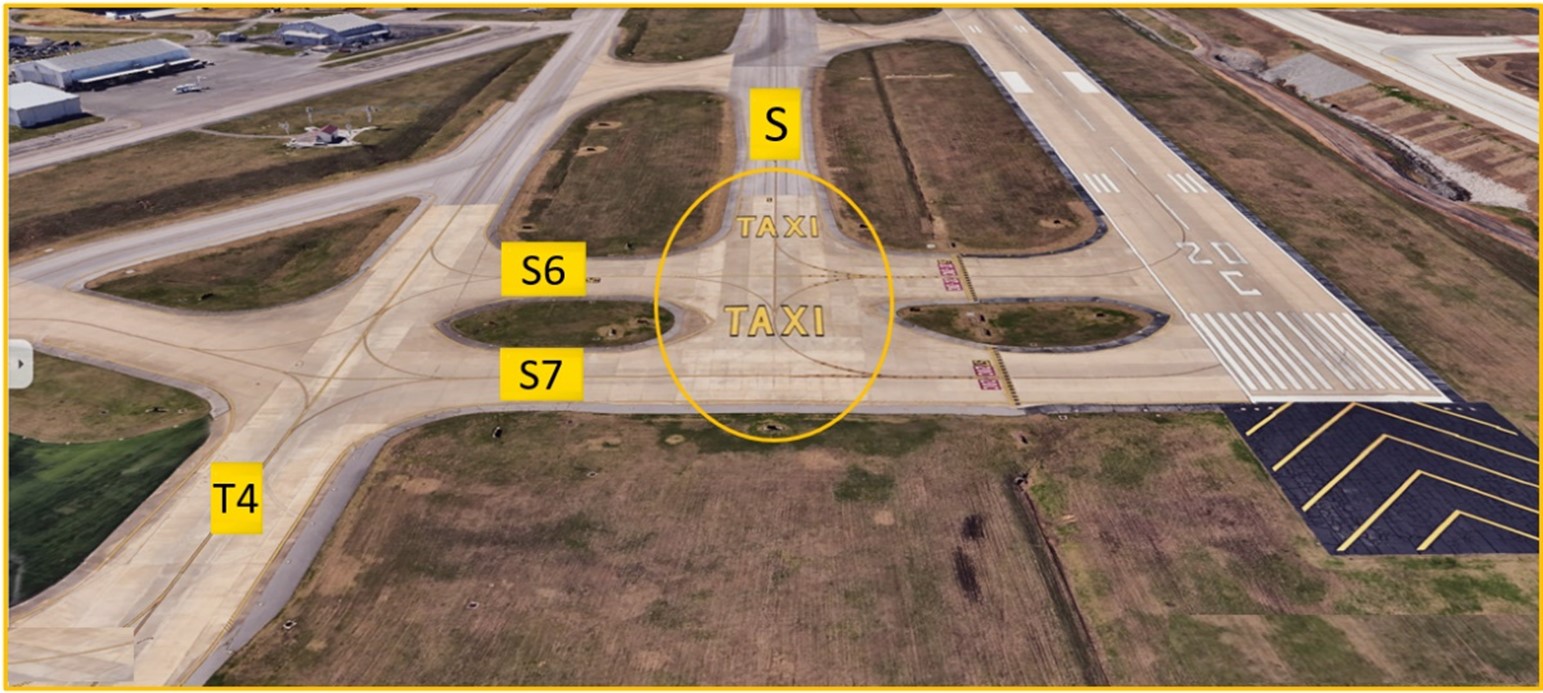
Surface Risk – Movement Area Cautions
- Approximately at the midpoint of RWY 2R/20L, two vehicle access roads, located between TWY H3 and TWY H4, connect the RWY and TWY H.
- The roads are wide enough to be confused for a taxiway exit point. Surface painted “Xs” and signs are present to prevent confusion.
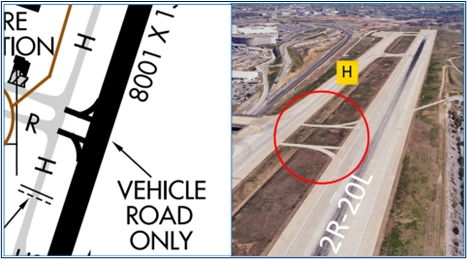
Wrong Surface Landing Risk
- Pilots cleared to land on RWY 20C have landed or attempted to land on RWY 20R.
- The RWYs are closely spaced however, the threshold for RWY 20C is considerably further south than the threshold for RWY 20R.
- Expectation bias may lead aircraft on right downwind for RWY 20C to attempt to land on RWY 20R because it comes into sight first.
- Whenever a TWY runs parallel to a RWY, the risk of landing on a TWY increases.
- The four RWYs at KBNA all have full-length parallel TWYs.
- If available, back up all visual approaches with an instrument approach to help ensure that you are lined up for the correct surface.
- View the From the Flight Deck-Wrong Surface Landings video for additional mitigation strategies
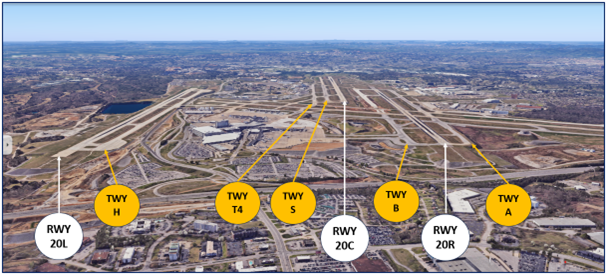
General
- No flight over main Terminal building permitted.
- Bird activity on and in vicinity of the airport.
- RWY 13/31 Thresholds Displaced.
- Check NOTAMS for construction activities/closures.
Traffic Patterns
- Practice approaches to the airport or conducting pattern traffic is not permitted between 2300L and 0700L.
Ground Control
- Pilots should be aware of the RWY 31 Approach Hold on TWY H between TWY R and TWY H2.
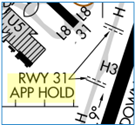
- At C concourse, the inner taxi-lane is for outbound traffic and the outer taxi-lane is used for inbound traffic.
- Aircraft at the Terminal Ramp should adhere to the information provided below:
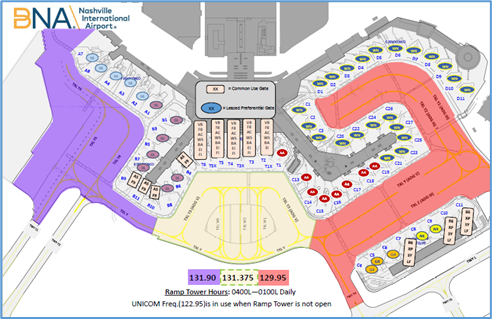
Takeoff/Departure
- Please read back all runway assignment and hold-short instructions with callsign.
- BNA utilizes “Line Up and Wait” (LUAW) to instruct a pilot to taxi onto the departure
- RWY and hold position until cleared for takeoff. It is not an authorization for takeoff. For mitigation strategies, view the From the Flight Deck-Line Up and Wait video.
Arrival/Landing
- Small aircraft landing RWY 20L may not be clearly visible from the TWR if they clear the RWY at TWY H4 or TWY H5. Unless specifically asked, a “cleared of RWY” call is not a requirement but, in this situation, may help the TWR for situational awareness.
- Nashville Airport Air Traffic Control Tower/Approach Control provides standard separation between VFR aircraft conducting practice instrument approaches and other aircraft under its control.
- Nashville Approach Control attempts to accommodate practice approaches as feasible, however, during peak traffic periods, delays may be encountered.
Special Traffic-Helicopters
- Class C encompasses the downtown Nashville area. With there being four major hospitals in the vicinity, numerous medevac helicopters transit through the airspace. While many remain under the shelf, some medevacs call the tower for mid-field crossings.
- Traffic permitting, the TWR will accommodate downtown tours in Class C.
- Landing on TWYs/ramp permitted during VFR conditions.
- Must land/depart from assigned RWY during IFR conditions.
